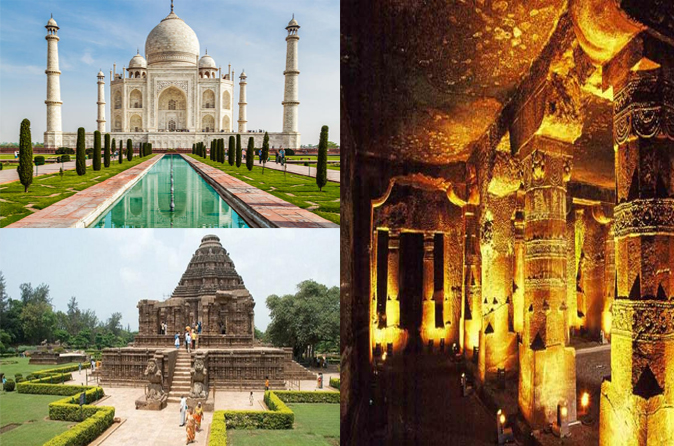News Highlight
On World Heritage Day 2023, a look at India’s top Heritage Sites.
Key Takeaway
- In 1982, the International Council on Monuments and Sites (ICOMOS) was formed.
- It was decided to observe April 18 as International Day for Monuments and Sites, often known as World Heritage Day.
- UNESCO approved it during its 22nd General Conference in 1983.
- The day is dedicated to recognising historical sites, promoting awareness about them, and emphasising the necessity of restoring and preserving them.
World Heritage Day 2023
- About
- Every April 18th, World Heritage Day promotes the importance and protection of all heritage places worldwide.
- People celebrate their cultural heritage daily by behaving in ways that reflect who they are and where they came from.
- On the other hand, one day each year is set aside to commemorate the human race’s shared past and present.
- On World Heritage Day, it is encouraged to commemorate all of the world’s cultures.
- It draws attention to central cultural locations and emphasises preserving these traditions.
- Theme
- “Heritage Changes” is the topic of World Heritage Day 2023.
- This subject emphasises volunteers’ role in preserving heritage places worldwide.
- ICOMOS announces a new theme on World Heritage Day each year.
- Significance
- World Heritage Day serves as a reminder of these sites’ cultural and historical significance.
- It emphasises the importance of protecting and preserving them for future generations.
- It also emphasises the importance of heritage monuments in promoting tourism, economic prosperity, and intercultural understanding.
- World History Day encourages people to respect and learn from various cultural views by honouring our global history’s diverse cultures and practices.
- It advocates worldwide cooperation and coordination to safeguard these areas.
- As well as the need for sustainable development considering each location’s natural and cultural past.
Status of Heritage Sites in India
- About
- India now has 40 UNESCO World Heritage Sites, making it the sixth-most numerous country in the world.
- There are 32 cultural sites, 7 natural sites, and one mixed-type site, Khangchendzonga National Park.
- India’s cultural heritage monuments include ancient temples, forts, palaces, mosques, and archaeological sites that reflect the country’s rich history and variety.
- National parks, animal reserves, and natural landscapes are examples of natural heritage sites in India.
- It highlights the country’s unique biodiversity and ecological value.
- The Khangchendzonga National Park in India is well-known for its cultural value.
- It is also known for its biodiversity, home to several rare and endangered species.
Constitutional and Legislative Provisions Related to Indian Heritage
- Directive Principles of State Policy
- Article 49 requires the state to conserve any monument, location, or object of aesthetic or historic interest.
- It has been proclaimed by or under a law established by Parliament to be of national importance.
- Fundamental Duty
- According to Article 51A of the Constitution, it is the obligation of every Indian citizen to cherish and conserve our country’s rich cultural legacy.
- AMASR Act 1958
- It is passed by the Indian Parliament, which protects ancient and historical sites.
- In addition to archaeological sites and remains of national significance, for the regulation of archaeological excavations and the protection of sculptures, carvings, and other similar things.
Issues Related to Heritage Management in India
- Lack of Centralised Database for Heritage Sites
- India lacks a comprehensive national-level database of heritage structure distribution by state.
- The Indian National Trust for Art and Cultural Heritage (INTACH) has catalogued around 60,000 buildings in approximately 150 cities.
- It is still the tip of the iceberg, as the country is projected to have about 4000 heritage towns and cities.
- Outdated Mechanism of Excavation and Exploration
- Geographic Information Systems and Remote Sensing are infrequently used in exploration due to outmoded techniques.
- Furthermore, municipal governments involved in urban heritage initiatives are frequently under-equipped to handle heritage conservation.
- Environmental Degradation and Natural Disasters
- Environmental degradation and natural calamities, such as pollution, erosion, flooding, and earthquakes, endanger heritage sites in India.
- It has the potential to do irrevocable damage to their physical structures and cultural value.
- For example, the Taj Mahal in Uttar Pradesh is a UNESCO World Legacy Site and an iconic representation of India’s cultural legacy.
- They had difficulties due to air pollution, which caused the marble to turn yellow and deteriorate.

Way Forward
- Investigating and implementing novel heritage conservation funding approaches such as public-private partnerships, corporate sponsorships, crowdfunding, and community-based funding.
- This can assist in generating new financial resources for heritage sites while ensuring their long-term conservation and upkeep.
- Encourage business donations for specific conservation programmes, for example.
- Firms might provide dollars and resources in exchange for brand awareness and promotional possibilities.
Pic Courtesy: India TV News
Content Source: Indian Express



